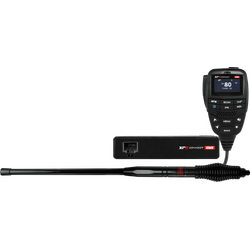UHF Radios
12V Dc Cigarette Lighter Lead - Suit All Uhf Cb Radios (Excluding Tx4600 / Tx4610)
Don't Pay RRP: $45.00
DTX4200XDV – Dual Receive UHF CB Radio with Dual Voltage and IP Rating
Don't Pay RRP: $499.00
UHF350DR + ANU240 Dual Receive UHF CB Radio Value Pack
Don't Pay RRP: $538.00
XRS - Connect IP67 UHF CB Radio With Bluetooth & GPS - XRS-390c
Don't Pay RRP: $629.00
Oricom DTX4200X and ANU1100 4x4 Ultimate Touring Pack
Don't Pay RRP: $549.00
Oricom DTX4300 IP54 UHF CB Radio + ANU220 Antenna Value Pack
Don't Pay RRP: $299.00
Oricom Dual Antenna System UHF CB with Controller Spk Mic
Don't Pay RRP: $379.00
Oricom Speaker Mic Suit UHF2100, 1280,2180,2185,2190,2195, 2500
Don't Pay RRP: $26.95
Oricom Waterproof IP67 Portable 5W UHF CB Radio - CAMO
Don't Pay RRP: $249.00
Oricom Waterproof IP67 Portable 5W UHF CB Radio Tradies Twin Pack
Don't Pay RRP: $559.00
When travelling with a convoy, in areas where there is no phone reception a UHF radio is probably the most essential piece of gear you can carry. A number of things can go wrong on challenging tracks and clear communication can be the difference between making it out undamaged or trapped in a rut. Other than for a bit of fun with friends, a UHF radio can be your saviour in the wild. After all, there are no guarantees when the next car will pass. It’s worth making yourself familiar with the emergency channels in Australia. Handheld UHF radios are a bare minimum but tend to run out of battery fairly quickly if used all day, but do come in handy when spotting a mate over a difficult obstacle. We highly recommend installing both a fixed UHF radio and portable system on serious journeys. You really can't go past the quality and reliabilty of a GME UHF radio or a Uniden UHF radio and don't forget to pick yourself up an antenna as they won't work without one! We even stock a great range of overhead roof consoles which make a great way to store the unit in a place that's out of the way and easily accessible.
Let's start with the basics, if this is your first purchase then it's important to understand some of the key facts around UHF radios and how to properly use them. There is a certain etiquette to using a UHF radio in the outback, which we will outline in the facts sheet below:
FAQ'S about UHF Radios:
How to use a UHF radio in Australia:
First of all let's understand what UHF means - It is an abbreviation for "ultra high frequency", essentially a device that uses electromagnetic waves that travel at a frequency between 3,000 and 300 megahertz. UHF signals were developed for use with televison broadcasting but the technology has since found its way to UHF radios and therefore available to the every day explorer.
A UHF radio is a must-have for long-distance travellers and caravanning enthusiasts. This is especially true if you travel beyond the wilderness and woodlands to the far reaches of Australia's outback, where cell phone reception is poor to non-existent. Caravan owners and travellers can travel far and explore vast stretches of the outback with a UHF radio without worrying about communication issues. If you get into danger (for example, your vehicle breaks down or you become lost), you can call for help or access emergency services using your trusty UHF radio.
UHF radios are also reasonably priced, from your run of the mill basic hand held models, right up to your premium antenna and UHF radio packages from either GME or Uniden. We recommend adding it to your family camping checklist and packing it with your other road trip requirements because a UHF radio offers so many benefits at such a low price. Of course, there's nothing stopping you from upgrading to a more expensive one with a larger antenna and greater reception. This useful guide to Australian UHF radio channels will help with using your UHF radio on the correct channels if you're going on a grand trip of the outback.
Are CB radios UHF or VHF?
Short answer: CB radios are UHF and VHF, CB is just a term for the type of channels that the unit has access to. UHF CB or "citizen band" radio is a two-way radio system that uses the 476.4250–477.4125MHz, radio wave for short-distance communications within a hundred kms. It is divided into 80 channels for various uses. The public can use the UHF CB band radio service, which has been approved by the governments of Australia, New Zealand, Vanuatu, and Malaysia. UHF CB offers 77 UHF channels, with 32 of them (16 output and 16 input) dedicated to repeater stations. Despite the fact that the service is technically available to everyone, not all CB radio channels are open to the public for various reasons. In fact, anyone found abusing particular UHF radio channels could face severe consequences. VHF standing for 'Very High Frequency' use lower frequencies, they are more susceptible to interference from other radios. UHF, on the other hand, is a superior signal for long-distance communication in general. When utilising radios indoors, such as in buildings or in urban areas, UHF is preferable.
For example, broad misuse of the legally assigned UHF emergency channel can result in incarceration or a substantial fine, or a few hundred dollars in lesser situations. As a result, understanding CB radio channels in general, as well as legally restricted channels and correct UHF CB radio etiquette, can be beneficial.
General-purpose UHF channels:
The following is information from the Australian UHF channel chart that you can use to determine which channel your CB radio should be set to by default for general use:
Channel 18: If you drive a 4x4 off-road camping truck or caravan, this is how people will find you if something falls off the side of your camper while travelling. This channel is for off-road adventurers in general.
Channel 10: For 4WD clubs or convoys, tune in to channel 10 on your UHF radio. Unless your club chooses to utilise a different channel, this is the default general use channel. The channel is also known as the National Parks Channel. At a nearby caravan park in town, meet up with other travellers and talk about your adventures.
Truck and large vehicle drivers frequently use Channel 40. This channel is Australia's primary source of information on road safety.
Switch to the above channels (18, 10 and 40) if you need to contact another camper or caravan owner, or a truck or 4WD driver, as these are all shared channels and open to anyone.
However, if you need specific public information, you can switch to other CB radio stations.
Only use channel 5 (or 35, a repeater output channel) in an emergency: If you or someone in your convoy is hurt or injured and there are no other options for contact, you should radio channel 5 for help. The Australian government has mandated that channels 5 and 35 be used solely for emergency purposes. Any misuse can result in prosecution or severe penalties if proven.
The road safety channel for Pacific Highway and Pacific Motorway is Channel 29. Tune in to this channel for traffic updates, road closures, and detours on these major thoroughfares. Lost friends can be found on Channel 11. If you lose contact with a friend on another channel, you can try to locate them using this call channel before switching to another. Channels for general use: You can agree to turn on most channels for general usage if you have a camper convoy with your buddies. Channels 9, 12 to 17, 19 to 21, 24 to 30, and 39 are available for the general band. You can choose from stations 50 to 60, 64 to 70, and 79 to 80 if your radio has extended bands.The authorised 'call channel,' Channel 11, is just for making calls and not for discussions or conversations. Channels 22 and 23 are reserved for telemetry and telecommand, as well as automatic data transmissions. Voice broadcasts are not permitted on channels 61, 62, and 63, which are earmarked for future allocation. With today's modern technology, triangulating the position of any UHF radio user detected abusing or misusing these channels is simple. As a result, it makes sense to avoid these frequencies when not in an emergency, particularly the CB emergency channels.
Can UHF and VHF radios communicate?
No. They are completely different frequencies. Also VHF radios are generally used in Marine applications.
How far can a UHF radio transmit?
Because UHF broadcast is limited up to 64 km by how far you can see the horizon from where you are standing and frequently to shorter distances by local geography, it permits other users in surrounding geographic areas to reuse the same frequency channels (frequency reuse). Otherwise all those channels would be bery busy and impossible to use.
How to test a UHF radio:
Jump on channel 40 and call out 'can I get a radio check cobba?' and if no one replies then make sure your antenna is connected properly, it may have shaken loose whilst bashing the tracks. Ensure the unit is on and try again. If you are using a handheld and have recently dropped it in the water or mud, some will continue to work whilst some won't.
How to install a UHF radio:
Please check out our handy installation video on Youtube to see how easy it is to do it yourself. Watch as we install an overhead Roof Console from 4WD Interiors along with a GME XRS UHF radio & Aerial on a Uniden Folding Bracket!
UHF Radio Etiquette:
Using a UHF radio can be exciting and interesting. However, just as there are standards to follow for caravan park etiquette, there are also regulations to follow for trouble-free radio use. When using a UHF radio, keep the following in mind: Apart from staying away from the legally forbidden channels 22, 23, 61, 62, and 63, you can only use channels 5 (or 35) and 11 if absolutely essential.
If you're utilising call channel 11 to locate a friend from your convoy, you'll need to switch to a different channel to continue your chat once you've established communication. As a result, the channel becomes available to other parties who require it. Any accessible general-purpose channel should be used to continue short-distance one-on-one interactions.
All public channel communications can be heard by any user (or repeater you're using) within range, allowing them to join in. UHF radio users, on the other hand, are generally well-behaved and follow correct etiquette. If you are aware that the channel you are using is in use (especially by locals in the region), please move to a different frequency. There may be times when you come across trolls or new users who aren't sure how to act. In such circumstances, simply ignore trolls (which are uncommon) and respectfully educate newcomers on proper radio etiquette. Have fun and stay safe when travelling with your UHF radio. The UHF radio is a fun and unique way to remain in touch with friends, a camping group, or a convoy. More crucially, it's a life-saving communication gadget that can be used in an emergency. And last but certainly not least, can we get a HOOOOOOIIIIIYYYYYAYEEEEEEEEEEEAAAAAAAA???????



































































